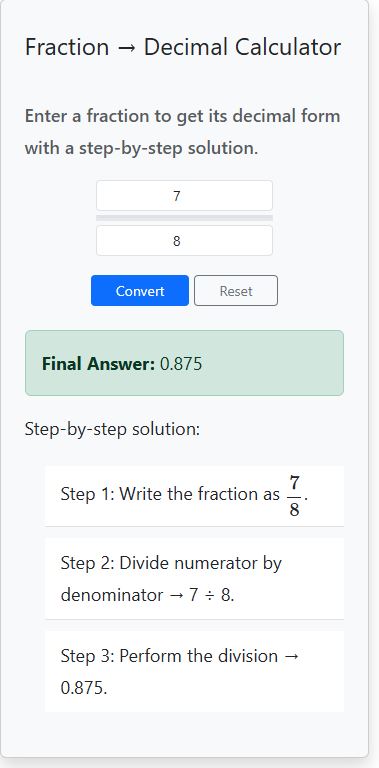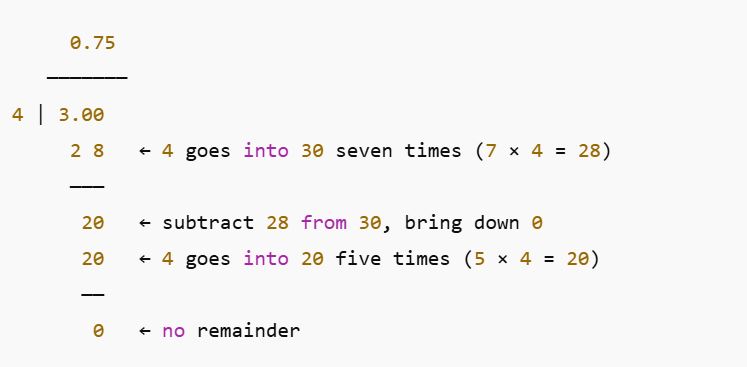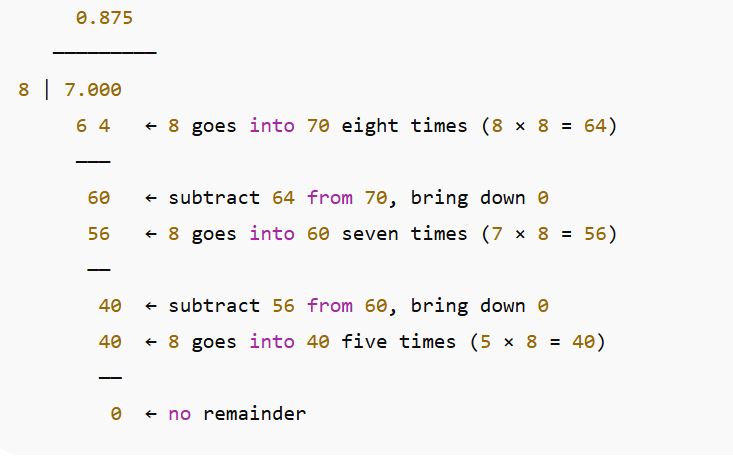Fraction to Decimal Calculator
Converting fractions to decimals is a common task in math and everyday life. A fraction shows a part of a whole, while a decimal expresses the same value in another form. Students often need to convert fractions to decimals when solving math problems, while teachers use it to explain concepts more clearly. Professionals in fields like engineering, finance, and even cooking also rely on quick conversions. To make this process easy, we have created a free Fraction to Decimal Calculator. With this tool, you can get instant and accurate results without doing the math by hand.
Enter a fraction to get its decimal form with a step-by-step solution.
Related Tools
- Decimal to fraction calculator
- Improper fraction to decimal calculator
What is a Fraction to Decimal Calculator?
A Fraction to Decimal Calculator is a simple online tool that converts fractions into decimals quickly and accurately. Instead of doing long division by hand, you simply enter the numerator and denominator and the calculator gives the decimal plus a step-by-step explanation of how it was done. This makes it useful for students doing math homework, teachers explaining lessons, and professionals from various disciplines. Thus, the tool acts as an instant fraction to decimal converter, allowing you to save time, reduce mistakes, and help you learn the process easily.
How to Use the Fraction to Decimal Calculator
Using the calculator is very easy. Just follow these steps:
- Enter the numerator (top number of the fraction).
- Enter the denominator (bottom number of the fraction).
- Click the “Calculate” button.
- The calculator will show the decimal answer.
- You will also see a step-by-step explanation of how the fraction was converted.
For instance, to convert 7/8 to decimal, simply enter 7 in the numerator and 8 in the denominator, and click the “calculate” button. The results will be as shown in Figure 1.

How to Convert a Fraction to Decimal without a calculator
You can convert fractions to decimals using long division. This means dividing the numerator (top number) by the denominator (bottom number). Here is how it works:
- Write the fraction as a division problem.
- Divide the numerator by the denominator using long division.
- Write the result as a decimal.
Here are some examples:
Example 1: Convert 3/4 to a decimal
To convert 3/4 to a decimal, you need to use the long division as follows:

Hence, 3/4 to decimal is 0.75
Example 2. Convert 7/8 to a decimal
You can easily convert 7/8 to a decimal using the long division formula as shown below:

Thus, 7/8 to a decimal is 0.875
Common Fractions and Their Decimal Equivalents
Many fractions are used so often that it helps to remember their decimal forms. Below is a table of some of the most common fractions and their decimal equivalents. This makes it easier to solve problems quickly without doing the division every time.
| Fraction | Decimal Equivalent | Notes |
|---|---|---|
| 1/2 | 0.5 | Exact |
| 1/3 | 0.333… | Repeating decimal |
| 2/3 | 0.666… | Repeating decimal |
| 1/4 | 0.25 | Exact |
| 3/4 | 0.75 | Exact |
| 1/5 | 0.2 | Exact |
| 2/5 | 0.4 | Exact |
| 3/5 | 0.6 | Exact |
| 4/5 | 0.8 | Exact |
| 1/6 | 0.166… | Repeating decimal |
| 5/6 | 0.833… | Repeating decimal |
| 1/8 | 0.125 | Exact |
| 3/8 | 0.375 | Exact |
| 5/8 | 0.625 | Exact |
| 7/8 | 0.875 | Exact |
| 1/10 | 0.1 | Exact |
| 9/10 | 0.9 | Exact |
Frequently Asked Questions
You can divide the numerator (top number) by the denominator (bottom number) using long division. For example, 3 ÷ 4 = 0.75. If you want to save time, you can use an online calculator for instant results.
Some fractions cannot be expressed as a finite decimal. For example, 1/3 becomes 0.333… because the division never ends evenly. These are called repeating decimals.
The fraction 7/8 equals 0.875 as a decimal. You can find this by dividing 7 by 8 or using a calculator.
Yes. Improper fractions, where the numerator is larger than the denominator (like 9/4), can be converted to decimals. In this case, 9 ÷ 4 = 2.25.
No. You can divide any fraction directly, whether it is simplified or not. For example, 4/8 will still give 0.5, just like 1/2.
These conversions are common in school math, engineering, finance, construction, and even cooking when measurements are given as fractions but need to be applied in decimals.